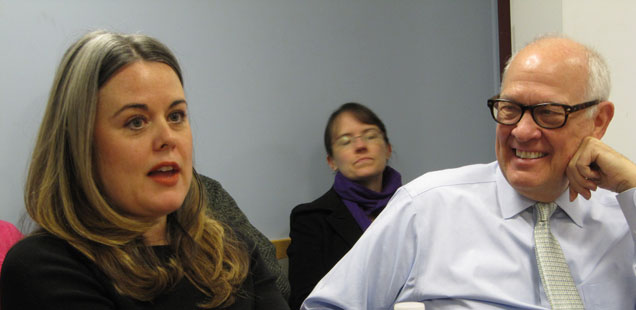February 24, 2015 — Meredith Artley, editor-in-chief of CNN Digital and president of the Online News Association, visited the Shorenstein Center to provide practical tips for journalists looking to improve the impact of their digital work.
- Slow down and focus. Artley acknowledged that journalists often feel overloaded, expected to produce content in multiple formats across a range of platforms. “That’s a very powerful thing – but it can be dangerous because it can mean that you’re removing yourself from the actual act of doing journalism that makes an impact,” said Artley. She advised journalists to have the discipline to say “this is what I’m good at doing, whether it’s a beat or a specific platform,” rather than trying to be “everywhere all of the time.”
- Pick a metric/measure of success that matters to you. For video journalists, a valuable metric might be video view completion rates. For writers, it might be time spent with text stories. Artley said that a recent story about three young women who were recruited by ISIS had an average time spent on page of 6.5 minutes – a high rate for the site – which told them that audiences had an appetite for a deeper dive into the story.
- Pick a social platform that suits you and suits your story. “Certain stories lend themselves to certain platforms,” said Artley. Generally, Facebook is good for video and evening publishing, “when people are at home, checking their phones and their feed.” Twitter might not be as useful for driving traffic to a site, but it is important for reaching an “influencer audience” and has a connection to TV viewing. Artley discussed how Nick Paton Walsh, a CNN international correspondent, created a series of videos and articles on the ISIS occupation of Kolbani, Syria, and then participated in a Reddit AMA (“Ask Me Anything”), which turned out to be an effective way of engaging audiences in a high-quality conversation about what Walsh saw on the ground.
- Publishing is not the end. “The old way of thinking is: put the story out, and when it’s out you’re done, you can walk away.” Now, said Artley, “publishing is the moment where you start to engage audiences, where you start to look at how it’s performing, where you think about how might I reach out to people using social media to help get my story seen, how can I listen to the conversation around my story and think about potential follow-ups?”
- Beware the big and shiny objects. Rather than immediately jumping on board with “the things that are going to take a lot of time and be big and beautiful,” (she cited The New York Times “Snow Fall” feature as an example) Artley recommended picking and choosing projects carefully, and taking an iterative approach to trying new things. “We don’t have to take something and hide it away for months and months…we might start by dipping our toe into a story…and look at the interest.”
Artley also discussed how analytics can be used to improve journalism — without compromising an outlet’s commitment to hard news. “It’s not saying ‘let’s not do Ukraine because nobody’s clicking on it.’ It’s saying ‘this is a critically important story – how do we need to position this…to reach the broadest audience?” she said. “Don’t simplify the argument into ‘data bad, journalistic instinct good.’”
Hear Artley share her tips for journalists, as well as the editorial process for CNN.com and the cable newscast, trends among international audiences, and CNN’s recent foray into Snapchat in the full audio recording above.
Article and photo by Nilagia McCoy of the Shorenstein Center.


